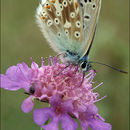Biology
(
англиски
)
добавил Arkive
In the common blue, the number of generations produced each year varies depending on the geographic location of the population. In the majority of England and Wales there are two broods per year (the populations are 'bivoltine'), with adults on the wing in May and June and again in August and September. Populations in Scotland and parts of England to the north of Yorkshire are single-brooded ('univoltine'); adults are present between June and September, with emergence occurring earlier in warmer areas. Occasionally, in warm years, double-brooded and single-brooded populations may go on to produce an extra brood in the same year, thanks to the warm weather. This phenomenon indicates that the factors governing the number of broods produced are environmental, rather than genetic (4).
The eggs are laid singly on the foodplants and take around a week to hatch (3). Caterpillars of the first generation (or of the only generation in single-brooded populations) take around 6 weeks to become fully developed. Second brood caterpillars overwinter when partly grown, and complete their development during the following year (3). Pupation occurs either at the base of the foodplant or amongst litter on the ground (4) and adult butterflies emerge after around two weeks (3).
In common with many other species of blue butterflies, the caterpillars of the common blue are attractive to ants when they are fully grown. The pupae are also attractive to ants and are often carried away into ant nests (4).
Conservation
(
англиски
)
добавил Arkive
Not relevant.
Description
(
англиски
)
добавил Arkive
The common blue is the most widespread of the blue butterflies in Britain (4), and as the name suggests, it is one of the most common butterflies in Europe (5). The males are a striking bluish-violet colour, but females are brown with orange spots near the margins of the wings. In both sexes, the undersides of the wings are greyish brown with blackish spots and orange crescents towards the margins of the wings (2). The caterpillar has a stout body, which tapers towards the tips. The head is black and the body is green. A darker green line bordered with white passes along the centre of the back. There is also a whitish-green line along the sides (3).
Habitat
(
англиски
)
добавил Arkive
Occurs in a wide range of grassy habitats where the foodplants occur. The main foodplant is common bird's foot trefoil (Lotus corniculatus), although other trefoils, clovers (Trifolium) and related plants may be used (2) (5). This species tends to be found in sunny, sheltered areas, and typical habitats include downland, woodland clearings, coastal dunes, road verges, golf courses, cemeteries and occasionally gardens (4) (5).
Range
(
англиски
)
добавил Arkive
This butterfly is found throughout Britain and occurs on most off-shore islands including the Outer Hebrides and Orkney (4). It is most numerous in the south of England and Wales and is scarce in areas at altitudes of over 300 meters, becoming absent over 500 m (4). Elsewhere, the range of this species extends throughout Europe, North Africa and in temperate parts of Asia (2).
Status
(
англиски
)
добавил Arkive
Not threatened (4).
Threats
(
англиски
)
добавил Arkive
This species is not threatened at present.

